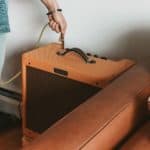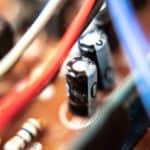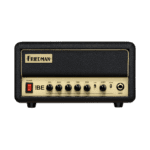You may have heard horror stories of performing musicians being shocked on stage or you may have experienced some shocks yourself while you were messing with music equipment. It can definitely happen under certain circumstances but it is not common.
You shouldn’t have to worry about being shocked through your guitar, even if playing barefoot if all of your equipment is working correctly. Usually, the weakest link in the chain is your amplifier so you should always procure to keep them well maintained and plugged into a safe energy source.
Before we get into what electrical problems can happen when you are playing guitar, I should say that working on amplifiers can be very dangerous even if they are unplugged.
Amps use high voltage (especially tube amps) and power capacitors need to be drained before repairs can be done. So don’t go poking around inside your amp unless you are qualified to do so.
Can an electric guitar shock you?
Technically your guitar itself can’t shock you but if there is a live electrical current in contact with your amp chassis then it can travel through your instrument cable to your guitar.
So yes it is possible that you can be shocked by touching the metal parts of a guitar without wearing insulated footwear or while touching other conductive objects.
How likely is it to happen?
With modern amplifiers and electrical wiring in buildings you usually don’t have to worry about being shocked.
If your amplifier is properly grounded with a modern and undamaged 3-prong plug, doesn’t have any loose wires or components inside, and the electrical outlets in the house/venue are properly wired, you should be in the clear.
On a side note, there can be situations where equipment (microphone/guitar amp) is powered by different electrical circuits (different ground connections) and people have been shocked by this.
Does playing electric guitar barefoot increase the risk of electrocution?
Electricity is trying to find a path to the ground and water is somewhat conductive. In an episode of Star Trek: The Next Generation, a silicon-based life form refers to humans as “Ugly, giant bags of mostly water” which is pretty true.
So since you are mostly water, electricity will pass through you to reach the ground.
Rubber is a great insulator so wearing shoes with rubber soles may interrupt the electric current and stop it from reaching the ground.
If you have visited an electronic repair shop you may have noticed that the technicians sometimes have rubber mats in front of their workbenches for insulation.
Keep in mind that touching other conductive surfaces (metal microphone) will create a new path so it’s not just your feet you have to worry about.
Are there any ways to avoid it?
Rather than putting shoes on to avoid being shocked, I think it’s best to attack the problem at its likely source: the amplifier.
Vintage amps: Older appliances and electrical outlets had non-polarized plugs and outlet jacks. So whether the hot or neutral wire was being plugged into the amplifier was up to chance.
Since one of the connections was attached to the amp chassis through a capacitor, it was possible for the hot wire to electrify the chassis which connects to your guitar through the instrument cable.
If you have a vintage amp with a 2-prong plug you need to have the power cable replaced with a modern polarized and grounded plug.
Modern amps: You will already have the proper AC cable on a modern amp but if your amp travels in a vehicle often or has taken a nasty fall, then the cable insulation could be damaged where it enters the chassis or a large electronic component could be knocked loose inside.
If something rattles inside of your amp or you notice damage near the grommet where the power cable enters the amp, it is time to have the amp serviced by a technician.
All amps: Don’t get them wet!
Is the electric guitar an inherently dangerous instrument?
I don’t think that there are serious risks with playing electric guitars, especially if you mostly play at home and trust your electrical wiring.
Your biggest concerns besides an unlikely electric shock are probably hearing loss from playing too loud or injuries from knocking over (or lifting) heavy gear.
Is the electric guitar safe for kids?
Playing electric guitar is a safe activity for children but definitely avoid older amplifiers with two-prong plugs or suspect wiring insulation.
I think practice amps such as the Blackstar Fly or Roland Microcube are an excellent option since they have external power supplies (wall warts) so the voltage is already reduced to 12 volts before it reaches the amp.
In addition, amps such as these are low wattage so you don’t have to worry about your children damaging their hearing.
Tips for performing electric guitar safely
Since you shouldn’t have to worry about being shocked by modern equipment that is in good working order, it is best to ensure that it stays that way.
If you use amp heads on top of cabinets or any amp that is not sitting on the floor, make sure the AC cord has enough slack so that it will not be pulled out or damaged if the amp is knocked over.
It’s probably easiest to do this by using power strips on the floor and keeping cords secured with tape or investing in an electrical cord cover.
Another method to bypass all of the electrocution risks is just to use a wireless transmitter system for your guitar. This also eliminates the risk of knocking over your amp by pulling on the instrument cable.
Finally, as stupid as it sounds, don’t sit drinks on top of your equipment; trust me, people do it all the time. What could go wrong?
These tips should help with the electrical risks but you are still dealing with loud noises and heavy equipment so maybe some earplugs and shoes aren’t such a bad idea after all.

Hello there, my name is Ramiro and I’ve been playing guitar for almost 20 years. I’m obsessed with everything gear-related and I thought it might be worth sharing it. From guitars, pedals, amps, and synths to studio gear and production tips, I hope you find what I post here useful, and I’ll try my best to keep it entertaining also.





